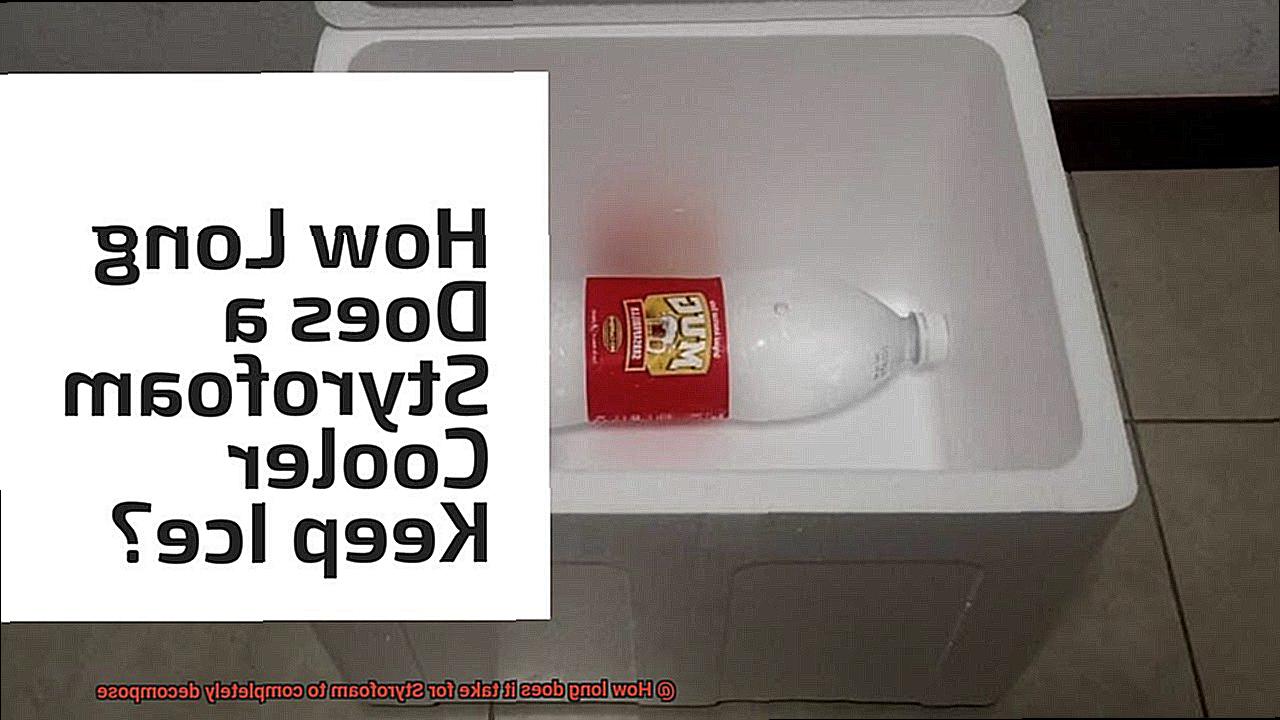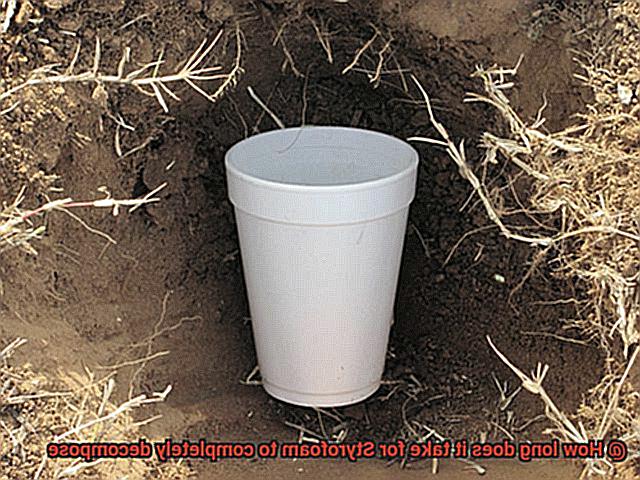Do you ever stop to ponder the effects of using Styrofoam cups or packaging on a daily basis? It’s simple to overlook the consequences of something as seemingly insignificant as disposable containers. However, did you know that Styrofoam can take hundreds of years to decompose?
Yes, it’s true. Even though it is lightweight and convenient, Styrofoam can sit in landfills for thousands of years, polluting our environment and harming wildlife. As it breaks down into smaller particles, it can also release harmful toxins into the soil and water.
So how long does it really take for Styrofoam to completely decompose? In this blog post, we will delve into the science behind the degradation of Styrofoam and explore the factors that influence the decomposition process. We will also discuss alternatives to Styrofoam and our daily consumption habits’ environmental impact.
It’s time to start considering the long-term consequences of our actions and make a conscious effort to reduce our use of harmful plastics. Join us on this journey of discovery as we uncover the truth about Styrofoam decomposition and its impact on our planet – our only home.
What is Styrofoam?
Contents
Styrofoam is a type of plastic that is widely used in packaging and insulation materials due to its lightweight and insulating properties. It is made from expanded polystyrene (EPS), a thermoplastic material that can be molded into any shape or size.
Styrofoam’s excellent insulation properties make it a popular choice for keeping food and beverages hot or cold. From takeout meals to disposable cups and plates, Styrofoam is everywhere. However, despite its convenience, this material poses serious environmental risks because it is non-biodegradable. It does not decompose naturally, meaning it can persist in landfills and oceans for hundreds or even thousands of years.
Styrofoam was first developed by Dow Chemical Company in the 1940s and has since become a widely used material in various industries. While it may be frequently confused with other types of foam materials such as polyurethane or polystyrene foam, it is important to understand the differences between these materials to make informed decisions about their use and disposal.
Fortunately, there are ways to mitigate the impact of Styrofoam on the environment. One approach is to reduce our use of Styrofoam by opting for more environmentally friendly alternatives. For instance, reusable containers made from glass or stainless steel can be a great alternative to Styrofoam takeout containers. Additionally, recycling Styrofoam through specialized facilities that can process it into new products is another solution.
Why Does Styrofoam Take So Long to Decompose?
The answer lies in the fact that Styrofoam is made from a type of plastic that is not easily broken down by living organisms in the environment, making it a significant environmental threat.
Styrofoam is not biodegradable, which means that it cannot be broken down by bacteria and fungi in the environment. Instead, it can take hundreds of years for Styrofoam to break down naturally, if at all.
In addition to its non-biodegradable properties, Styrofoam is resistant to photodegradation. This is the process by which materials break down when exposed to sunlight. However, Styrofoam does not break down easily when exposed to sunlight. Instead, it breaks into smaller and smaller pieces known as microplastics, posing a significant threat to wildlife and the environment.
Furthermore, Styrofoam is also resistant to chemical degradation. This process occurs when materials break down after exposure to chemicals such as acids or alkalines. Unfortunately, Styrofoam does not break down quickly when exposed to these chemicals and can release harmful chemicals into the environment as it breaks down.
Overall, Styrofoam takes so long to decompose because it is not biodegradable and resistant to both photodegradation and chemical degradation. This poses a significant threat to the environment as it can accumulate in landfills and natural habitats, harming wildlife and polluting our ecosystem.
The Environmental Impact of Styrofoam
If you’re like most people, you’ve probably come across Styrofoam at least once in your life. It’s a widely used material that’s cheap and lightweight, making it perfect for packaging and insulation. However, the environmental impact of Styrofoam is a cause for concern.

Styrofoam is not biodegradable, which means it takes hundreds of years to decompose. When it’s discarded into landfills or the environment, it persists in its original form for centuries, contributing to pollution and posing a significant threat to wildlife and ecosystems.
But that’s not all. Styrofoam can also release harmful chemicals into the environment during production and disposal. These chemicals can contaminate soil and water sources, leading to potential health risks for humans and animals.
So what can we do to reduce the negative effects of Styrofoam? One solution is to turn to alternative materials such as biodegradable plastics or paper-based products. These materials break down naturally and do not pose a threat to the environment in the same way that Styrofoam does.
Recycling programs for Styrofoam have also been implemented in some areas, although this process can be challenging due to the material’s lightweight and bulky nature. Proper disposal of Styrofoam is crucial, as it can take up valuable space in landfills and contribute to pollution.
Strategies for Reducing the Use of Styrofoam
Styrofoam, also known as polystyrene, is a material widely used in various industries due to its lightweight and insulating properties. But did you know that it takes hundreds of years to decompose, making it one of the most environmentally damaging materials? That’s why reducing the use of Styrofoam is crucial for the health of our planet.
Luckily, there are several strategies we can implement to reduce Styrofoam usage. Firstly, we can replace it with more sustainable alternatives like paper-based packaging, cardboard, or biodegradable materials. By doing so, we can significantly reduce waste and pollution while still ensuring our products remain insulated.
Another strategy is to encourage recycling. Many local recycling programs now accept Styrofoam, but it’s important to make sure it’s clean and free from any contaminants before recycling. Some companies have also implemented take-back programs where they collect used Styrofoam products and recycle them for future use.
Education and awareness campaigns can also help reduce Styrofoam usage by informing people about its harmful effects on the environment. By making informed decisions about their purchases and choosing more sustainable options, people can do their part in protecting our planet.
Governments and businesses can also play a role by implementing policies that restrict the use of Styrofoam in certain industries or settings. For example, some cities have banned Styrofoam in restaurants and other food establishments.
Lastly, supporting sustainable initiatives like composting programs, community gardens, and local farmers’ markets can also help reduce Styrofoam usage. These initiatives often use biodegradable materials or reusable containers instead of Styrofoam.
Recycling Options for Styrofoam
Styrofoam is one of those materials that can be a bit of a headache to dispose of responsibly. Its lightweight and bulky composition make it difficult to recycle, but not impossible. In fact, there are a few recycling options available for those of us who want to reduce the amount of Styrofoam waste that ends up in landfills.
One option is to take your Styrofoam waste to a specialized recycling facility. These facilities use a process called thermal densification, which involves melting down the Styrofoam and compressing it into dense blocks that can be used as raw material for new products. While these facilities may not be widely available in all areas, it’s worth checking if there is one near you that accepts Styrofoam for recycling.
Another option is to look for mail-back programs offered by companies that specialize in Styrofoam recycling. This option allows individuals and businesses to send their Styrofoam waste directly to the recycling company for processing. While it may not be as convenient as dropping off your waste at a local recycling center, it can be an excellent solution for those who do not have access to other recycling options.
Finally, some cities and municipalities offer Styrofoam recycling programs as part of their regular curbside pickup services. If your area provides this service, ensure that you follow any specific guidelines or instructions given on how to prepare the material for pickup.
Alternatives to Using Styrofoam
Fear not. There are several alternatives available that are better for the environment and just as effective.
One popular alternative is using biodegradable or compostable materials. These materials break down naturally over time and do not harm the environment. Imagine using paper products, cardboard, or even some plastics made from plant-based materials. Not only are these options environmentally friendly, but they are also affordable.
Another amazing alternative is using reusable containers or packaging. This option reduces waste and saves money in the long run. Stainless steel, glass, and silicone containers are all great options for storing food and beverages without the need for single-use Styrofoam containers. By choosing this approach, you can reduce your carbon footprint and preserve the environment for future generations.
Lastly, some companies have started using innovative new materials to replace Styrofoam. Ecovative Design has created a material made from mushroom roots that can be used as a sustainable alternative to Styrofoam. Other companies have developed materials made from seaweed, sugarcane, and even shrimp shells. These new alternatives are natural, biodegradable, and better for the environment.
6ygvXUsqhIw” >
Conclusion
To sum up, Styrofoam is a ubiquitous material that poses a significant threat to the environment due to its non-biodegradable nature. It can take hundreds of years to decompose, and during production and disposal, it releases toxic chemicals into the environment. However, we don’t have to sit idly by as this problem persists.
There are several ways we can reduce our reliance on Styrofoam and minimize its impact on the planet. For example, we can opt for biodegradable or compostable materials, reusable containers, or innovative alternatives like mushroom roots, seaweed, sugarcane, or shrimp shells. Recycling programs using thermal densification or mail-back options have also been established in some areas.
Educating people about the harmful effects of Styrofoam and promoting awareness campaigns can encourage individuals to make informed decisions about their purchases. Governments and businesses can also play an essential role by implementing policies that restrict the use of Styrofoam in certain industries or settings.
By taking these steps, we can significantly reduce waste and pollution while still ensuring our products remain insulated.





